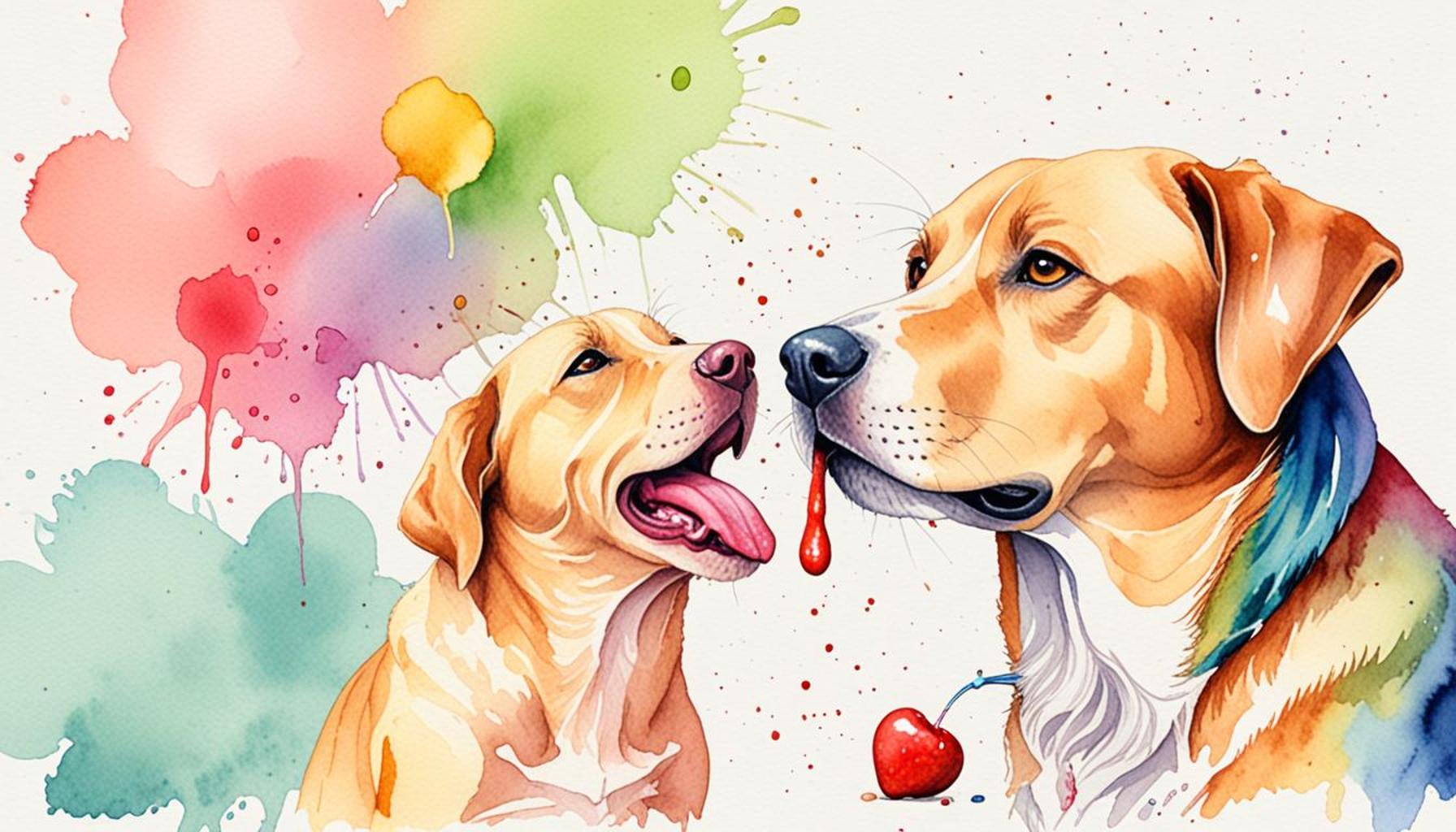The Psychology of Licking Behavior: What This Act Reveals About the Emotional Health of Dogs

The Complexity Behind Licking Behavior in Dogs
Have you ever observed your dog licking its paws or your face and wondered about the motivations behind this behavior? The act of licking is more than a mere habit; it intricately ties into various aspects of a dog’s emotional health and psychological state, revealing a wealth of information about their inner world.
Licking serves multiple purposes, each with distinct meanings that can provide insights into what your canine companion may be experiencing:
- Comfort: Dogs frequently lick not just as a grooming mechanism but also as a way to self-soothe. By licking, they release endorphins, promoting a sense of calm and comfort. This behavior can often be observed in puppies, who instinctively lick their mother for safety and reassurance.
- Stress Relief: Just like people may bite their nails or fidget when anxious, dogs might lick as a coping strategy. Situations like thunderstorms, fireworks, or even changes in their routine can trigger anxiety, leading to increased licking behavior as they seek relief.
- Communication: Dogs are social animals, and licking can serve as a form of communication. When a dog licks another dog’s face, it may be signaling submission or seeking bonding. Similarly, they might lick their owners as a playful gesture or a request for attention.
Experts in canine behavior suggest that understanding these underlying reasons is crucial for promoting your dog’s emotional and psychological well-being. For instance, if you notice your dog engaging in excessive licking, it could be a sign of stress or even an underlying medical issue, such as allergies or skin infections. Regular grooming and veterinary check-ups are essential to address these concerns.
Consider specific scenarios related to licking behaviors:
- Frequent licking of paws: This behavior might indicate boredom or allergies, which could stem from environmental triggers like pollen or certain materials in their bedding.
- Licking other dogs’ faces: This action can be a gesture of submission or an effort to bond, showcasing a display of empathy and friendship within the canine social structure.
- A sudden increase in licking: If your dog suddenly starts licking more frequently, it may hint at anxiety or discomfort, spotlighting the importance of paying attention to changes in their behavior.
As we explore the nuances of licking behavior, it is evident that this action functions as a vital window into your dog’s emotional landscape. Recognizing and understanding these behaviors helps dog owners create a nurturing environment, improving the overall well-being of their furry friends. By tapping into these insights, we open the door to a happier and healthier life for our pets, enabling them to thrive alongside us in our daily lives.

LEARN MORE: Click here for tips on creating a pet-friendly space
Deciphering the Language of Licking
Licking behavior in dogs serves as a powerful indicator of their emotional well-being, often revealing more than just physical needs. By paying close attention to the contexts in which licking occurs, pet owners can gain valuable insight into their dog’s emotional state. Understanding these cues is essential for promoting a harmonious relationship and ensuring a high quality of life for our furry companions.
Licking can be classified into several primary categories, with each type hinting at different emotional triggers. Here are some key licking behaviors and what they may signify:
- Self-Grooming: While grooming is a natural behavior, excessive licking can suggest discomfort or irritation. If your dog’s licking derails into an obsession, it might be necessary to visit a veterinarian to rule out skin conditions, allergies, or even pain.
- Social Bonding: When dogs lick each other, they often reinforce social connections. This licking can express affection, trust, and acceptance within their pack. In households, a dog licking a family member can signal love or an invitation to engage in social activities.
- Anxiety-Driven Licking: For many dogs, licking becomes a way to alleviate stress and anxiety. Situations that provoke fear or discomfort—like thunderstorms or new environments—can trigger excessive licking as an automatic response, seeking relief from the situation.
- Curiosity: Dogs are naturally curious creatures, and they often explore their environment through licking. This behavior can be a normal part of their exploration, but it’s important for pet owners to assess the surfaces or items being licked, as some can harbor harmful substances.
Recognizing these patterns is crucial for understanding your dog’s emotional landscape. For instance, if a dog that usually engages in social licking suddenly retreats into more solitary licking behavior, it may indicate that something is amiss, possibly signaling stress or discomfort in their environment. Regular observation and understanding of the specific triggers behind licking can help dog owners intervene effectively, fostering emotional health and well-being.
Veterinarians and animal behaviorists agree that addressing excessive licking is essential not just for the physical health of the dog, but also for their emotional state. Providing a supportive environment, with ample mental and physical stimulation, can significantly reduce licking behaviors prompted by boredom or anxiety. Engaging dogs in interactive play or teaching them new tricks serves not only to bond with them but also to divert their attention from compulsive licking.
In summary, the act of licking in dogs is a multifaceted behavior that encapsulates various emotional responses. By paying close attention to the specific contexts and types of licking, dog owners can detect signs of discomfort, anxiety, or a need for affection—protection and care essential for nurturing the emotional health of their canine friends.
The Psychological Significance of Licking in Dogs
The licking behavior of dogs is often dismissed as a mere physical act; however, it encompasses profound insights into their emotional health. Understanding why dogs lick can reveal much about their mental state and overall well-being. For instance, licking can serve as a self-soothing mechanism. When dogs experience stress or anxiety, they may lick themselves or objects in their environment to provide comfort. This behavior mirrors that seen in humans who engage in similar actions when seeking solace.Moreover, licking can be a form of communication between dogs and their owners. Dogs often lick their humans to express affection or seek attention. This social licking can strengthen the bond between the pet and its owner, leading to a deeper emotional attachment. Experts argue that the frequency and context of licking can signal an array of emotions, including joy, submission, or even a plea for support during tough times.To further illuminate the issue, studies indicate that excessive licking can be symptomatic of underlying health problems, ranging from allergies to behavioral disorders. This suggests that awareness of licking patterns can enable pet owners to be proactive in their dogs’ healthcare. Recognizing the nuances of licking behavior and its emotional implications is vital for maintaining a dog’s happiness and health.In summary, the licking behavior of dogs plays a significant role in revealing their emotional states. By observing and interpreting this behavior, pet owners can enhance their understanding of their dog’s needs and overall well-being. Whether comforting themselves or communicating affection and anxiety, dogs use licking as a key avenue for interaction and emotional expression.
DIVE DEEPER: Click here to learn more
The Implications of Licking Behavior on Canine Emotional Health
Exploring the significance of licking behavior extends beyond mere observation; it opens a window into the complex emotional lives of dogs. Delving deeper into the nuances of licking can lead to a better understanding of their psychological well-being and may help in identifying underlying issues that require attention.
One of the most impactful revelations about licking behavior is its association with stress relief. In studies conducted by animal behaviorists, it has been highlighted that dogs often engage in licking to self-soothe during times of heightened anxiety. This compulsive action can serve as a calming mechanism, similar to how humans may use repetitive behaviors—such as tapping a foot or biting nails—to cope with stress. Recognizing signs of anxiety-induced licking can be critical for timely interventions, such as introducing calming techniques, providing safe spaces, or procuring behavior modification resources.
Furthermore, the importance of environmental factors cannot be overlooked. A dog raised in a high-stress environment—characterized by loud noises, chaotic household dynamics, or a lack of mental engagement—can exhibit heightened licking behaviors as a coping strategy. For instance, dogs living in urban areas may react to development noises or unfamiliar scents by licking themselves or nearby objects. Creating a serene environment with structured routines can often mitigate these stress responses. Providing dogs with spots for retreat, such as comfortable beds or quiet corners, can enhance feelings of security.
In addition, the link between licking behavior and attachment and bonding is noteworthy. Research indicates that licking behaviors toward humans often correlate with the psychological concept of attachment theory. Dogs that lick humans frequently may be exhibiting attachment-driven behavior, seeking affection and affirmation from their owners. Contributions to building such connections can include positive reinforcement training and regular physical interaction. This reinforces the bond and addresses any emotional deficiencies that may cause a dog to seek comfort through licking.
Importantly, it is essential for dog owners to distinguish between healthy and problematic licking. While occasional licking can be a display of affection, excessive licking may suggest underlying emotional disturbances. In these cases, intervention can be paramount—seeking guidance from animal behaviorists or trainers can equip owners with strategies to redirect this behavior. By employing techniques such as increased exercise, puzzle toys, and social activities, owners can satisfy their dog’s behavioral needs while enhancing their emotional resilience.
Moreover, advances in veterinary science have shed light on the role of physical health in emotional behaviors. Some medical issues can lead to stress or discomfort, which may manifest through licking. Conditions such as allergies, gastrointestinal issues, or even dental problems may prompt dogs to lick excessively or inappropriately. Regular check-ups can help rule out physical ailments and contribute to a holistic understanding of a dog’s licking habits.
Engaging with a dog’s licking behaviors offers a unique glance into their emotional health, enabling owners to identify potential concerns and enhance their quality of life. By understanding the intricate relationship between licking and canine emotional states, pet owners can foster a nurturing environment that supports both physical and psychological wellness.
DISCOVER MORE: Click here to learn about your pet’s emotions
Conclusion: Understanding Your Dog Through Licking Behavior
The exploration of licking behavior in dogs unveils a profound understanding of their emotional health and needs. As highlighted, this seemingly simple act can serve multiple purposes, from stress relief to strengthening bonds with their human companions. Recognizing the nuances of licking behavior not only allows owners to appreciate their dog’s emotional states but also empowers them to make informed interventions when necessary.
By considering the environmental factors that contribute to licking—such as noise, chaos, or lack of engagement—owners can create a more serene and supportive space that promotes psychological well-being. Furthermore, understanding the attachment dynamics can transform the owner’s interaction with their pet, fostering deeper connections that enhance both the dog’s and human’s emotional health.
Importantly, discerning between occasional and excessive licking is crucial. While licking can be a nurturing behavior, excessive actions often indicate underlying issues that warrant attention. By utilizing strategies such as increased exercise, mental stimulation, and ensuring regular veterinary visits to address any potential physical health issues, pet owners can proactively meet their dogs’ needs.
Ultimately, embracing the psychology behind licking behavior invites dog owners to open a dialog about their pets’ emotional health. In this journey, not only can owners enhance the quality of life for their companions, but they can also deepen their bond, creating a mutual understanding rooted in love and respect. The more we learn about the emotional intricacies of our dogs, the better equipped we are to support their well-being, leading to happier and healthier lives for both pet and owner.



